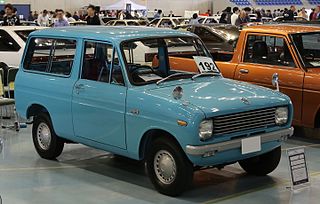
The Mazda Porter and Porter Cab are a series of small kei trucks that were produced from 1961 to 1989 by Mazda, mainly for sale in the domestic Japanese market. Export versions of the Porter were labelled E360. The Porter was replaced by the Autozam Scrum, a rebadged Suzuki Carry.
After an early flirtation with V-twin engines, Mazda's small cars of the 1960s were powered by OHV straight-2 and straight-4 engines. This family lasted from 1961 until the mid-1970s. Today, Mazda's keicars use Suzuki engines. It was produced at the Hiroshima Plant in Hiroshima, Japan.
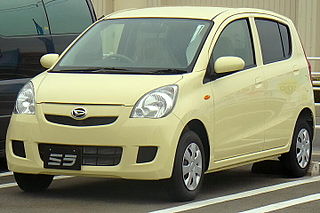
The Daihatsu Mira is a kei car and city car built by Japanese car maker Daihatsu. It has a variety of options and chassis variations, with the latest variant having four models: Mira, Mira AVY, Mira Gino, and Mira VAN. The Mira is the latest successor to the line of cars begun with the Daihatsu Fellow of 1966, and was originally introduced as the commercial version of the Cuore. Outside of Japan, the Mira has also been offered with larger 850 or 1000-cc engines. In Australia, the two-seater version was marketed as the Daihatsu Handivan and later as the Daihatsu Handi. The term mira is Latin meaning "goal" or "purpose".

The Daihatsu Fellow Max is a small Japanese automobile in the Kei car class. Originally introduced as the Daihatsu Fellow, the name was partially retained for its successor, the Max Cuore (1977), and then revived in 2000 for the Daihatsu Max.

The Mitsubishi Minica is a kei car produced by Mitsubishi Motors mainly for the Japanese domestic market from 1962 to 2011. It was first built by Shin Mitsubishi Heavy-Industries, one of Mitsubishi Heavy Industries' three regional automotive companies until they were merged in 1964, and as such predates MMC itself. In Japan, it was sold at a specific retail chain called Galant Shop. In 2007 and 2011, the car was replaced with the Mitsubishi eK and the Mitsubishi i.
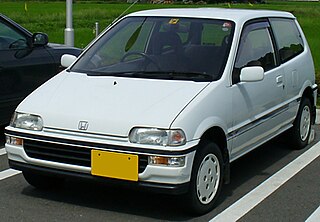
The Honda Today is a kei car produced by Japanese automaker Honda beginning in 1985. It was replaced by the Honda Life in 1998.
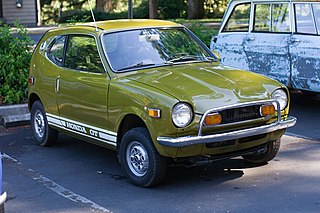
The Honda Z is a two-door hatchback kei car/city car manufactured and marketed by the Honda Motor Company, from 1970 until 1974. Exports mostly ended after 1972, when the domestic market models received redesigned pillarless bodywork.

The Daihatsu Hijet is a cab over microvan and kei truck produced and sold by the Japanese automaker Daihatsu since 1960. Despite the similarities between the Hijet name and Toyota's naming scheme for its trucks and vans, the name "Hijet" has been in use for Daihatsu's kei trucks and microvans since 1960, over two decades before Toyota took control. "Hijet", when transliterated into Japanese, is very similar to "Midget", one of Daihatsu's other mini-trucks. According to Daihatsu, the name "Hijet" was created to imply that the vehicle offers higher performance than the Midget. The Hijet competes in Japan with the Honda Acty, Mitsubishi Minicab, Nissan Clipper, Subaru Sambar and Suzuki Carry.

The Honda Acty is a series of cabover microvans and kei trucks produced by the Japanese automaker Honda from 1977 to 2021, designed for the Japanese domestic market (JDM). "Acty" is short for "Activity".

The Honda Life is an automobile nameplate that was used on various kei car/city cars produced by Honda: passenger cars, microvans, and kei trucks. The first series of the nameplate was built between 1971 and 1974, with the nameplate revived in 1997 and used until 2014. The Japanese-market Life has rarely been marketed outside Japan.

The Honda N360 is a small front-engine, front-wheel drive, two-door, four-passenger car manufactured and marketed by Honda from March 1967 through 1970 in Japan's highly regulated kei class — as both a two-door sedan and three-door wagon.

The S500 was the second production car from Honda, released in 1963, following the T360 truck into production by four months. It was a larger-displacement variant of the S360 roadster which, though developed for sale in 1962, was never produced.

The Honda S360 is a prototype sports car with a 360 cc (22 cu in) engine developed by Honda. It was one of the first automobiles created by the company known for their motorcycles. The S360 was unveiled on 5 June 1962 during the 11th Nation Honda Meeting General Assembly held at Suzuka Circuit, but was never put into production. It used a 356 cc AK250E series DOHC inline-four engine shared with the Honda T360 kei truck.

The Subaru Sambar is a cabover truck and microvan manufactured and marketed by Subaru as Japan's second truck compliant with the country's strict Keitora (軽トラ) or Kei vehicle tax class, after the Kurogane Baby. Introduced in 1961 in microvan and Kei pickup configurations, the Sambar remains in production, now in its eighth generation — beginning with the sixth generation as a rebadged Daihatsu Hijet.
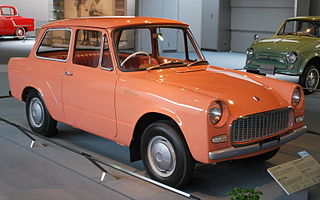
The Toyota Publica is a small car manufactured by the Japanese company Toyota from 1961 until 1978. Conceived as a family car to fulfill the requirements of the Japanese Government's "national car concept", it was the smallest Toyota car during that period and was superseded in that role by the Toyota Starlet, which itself started out as a version of the Publica. It was available as a 2-door vehicle only, but in a selection of body styles, ranging from the base sedan through a station wagon, convertible, coupé and even a coupe utility (pickup), which outlived the other models by a decade, and spawned other models, such as the Toyota Sports 800 and the Toyota MiniAce.

The Suzuki Carry is a kei truck produced by the Japanese automaker Suzuki. The microvan version was originally called the Carry van until 1982 when the passenger van versions were renamed as the Suzuki Every. In Japan, the Carry and Every are kei cars but the Suzuki Every Plus, the bigger version of Every, had a longer bonnet for safety purposes and a larger engine; export market versions and derivatives have been fitted with engines of up to 1.6 liters displacement. They have been sold under myriad different names in several countries, and is the only car to have been offered with Chevrolet as well as Ford badges.

A kei truck, kei-class truck, or Japanese mini truck is a mini truck, a type of pickup truck available in rear-wheel drive or four-wheel drive versions, built to satisfy the Japanese keijidōsha statutory class. They are known as keitora in Japan alongside the microvan.

The TN360 and its successors in the long running TN series is a cab over pickup truck from Honda, which replaced the T360 in November 1967.

The Honda S660 is a sports car in the kei class manufactured by the Japanese company Honda from 2015 until 2022. It is a two-seater with a targa top and a transverse mid-engine and rear-wheel-drive layout. It is the successor to the Honda Beat, and the Honda S2000.
The Daihatsu New-Line was a compact series of pickup trucks and vans built by Daihatsu from 1963 until 1968. They were based on the Daihatsu Hijet "keitora" and microvans, although they were somewhat larger and sturdier. The 797 cc inline-four engine also seen in the Daihatsu Compagno was fitted, rather than the 356 cc two-stroke unit seen in the Hijet.




















